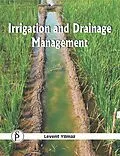The hydraulics of flow in the irrigation and drainage channels is indeed complex for many reasons in natural conditions. Such channels are required to carry a certain specified discharge of water which is charged with sediment load of suspended and bed material. The boundaries of the channel are thus in a state of constant flux. Bed and banks, although initially flat surfaces, may soon be covered with ripples and dunes. These are in effect large elements of surface roughness having a strong influence on the overall channel friction. Stability of these channels is defined as a state of equilibrium such that the particles on the surface of such channels are in a critical condition of movement. A channel shape which ensures that the particles everywhere on the channel surface are subjected to a resultant boundary stress which equals the critical shear stress is a stable profile. When the capacity for transporting sediment of a channel is equal to the time rate of sediment supply at its head, it is said to be a stable channel. Stable channels are also sometimes called regime channels. Recent empirical and theoretical work on irrigation channels suggests in natural form that instability is inherent. An occurrence of multiple cut-offs at river meanders could be interpreted as a clustering associated with self-organized criticality. Types of meander behaviour ranging from stable to chaotic are examined as trajectories or attractors within the phase space of rate of meander movement and bend curvature and change to the system is explored as shift from one attractor to another. It is suggested that this new approach provides insights into meander dynamics and provides a basis to identify the conditions, limits and constraints under which different behaviour occurs. Meanders have been subject to much analysis, of various kinds, in fluvial geomorphology because of their remarkable forms, their dynamism and the practical consequences of their movement. The aim of this book is to examine evidence of complex behaviour at natural irrigation and drainage boundaries, and, in particular, possible operation of self-organized criticality in meandering systems, using primary evidence of a field study and also evidence from a kinematic model.
Autorentext
Levent Yilmaz was born In Gelibolu, Turkey in 1950, And Finished Technical university Of Istanbul, Civil Engineering Faculty At 1974. After the Graduation He Worked At ENKA Construction Company At The istanbul Ataturk Airport Construction - Site Two Years Between 1975 -1977. He Finished His Ph. Degree Thesis About "The computation Of Drainage Characteristics Of Suburb Area" At Technical university Of Istanbul In 1977. After The Ph. Degree He Worked Asresearch Assistant At The Hydraulic Department Of Civil engineering Faculty At The Same University. Between The Years 1988 - 1990 He Worked As Research Associate At The Berlin Technical university In Institute Water Construction And Water Resources Management. Between the Years 2000 To 2002 He Worked As Visiting Scholar At The Louisiana State Universityat The Geo Science Department In Baton Rouge.
